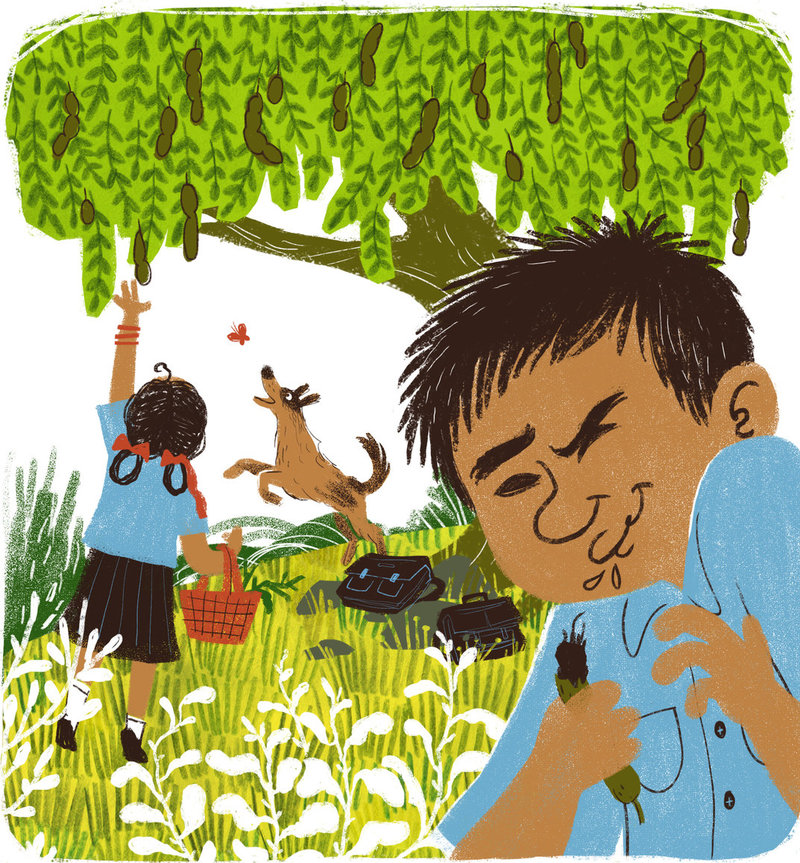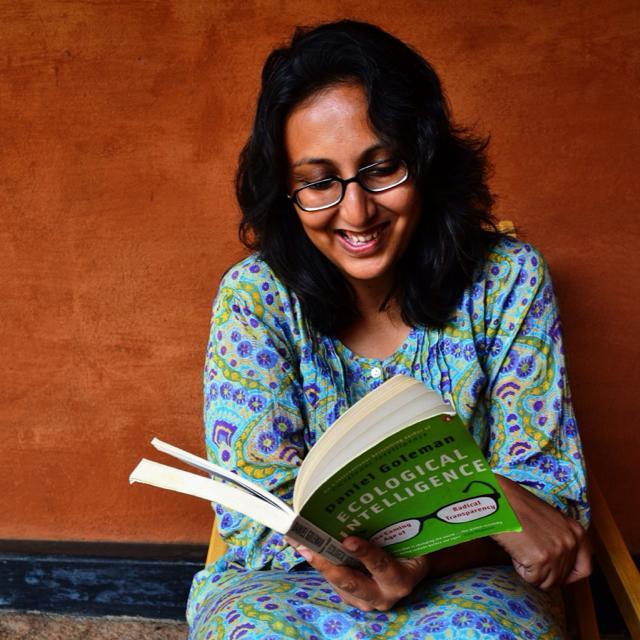StoryWeaver is Celebrating National Science Day
Posted by Remya Padmadas on February 28, 2016Why do bees buzz? How far is the sun from the earth? How long does it take for a forest to grow? Do robots have feelings? Why do I look like my grandmother?
Exasperating, exhausting, invigorating - a child’s curiosity can be any of the above and all of the above. As the adults in their lives, it’s up to us to set them on the path to discovering the answers to their questions.
February 28th is National Science Day in India and StoryWeaver is curating a week-long celebration of curiosity and learning with a collection of non-fiction books that touch upon Science, Technology, Engineering and Mathematics (STEM) to mark the occasion.

While there's plenty of great fiction being published for children in India today, there is still a dearth of simple, compelling non-fiction for young readers. Pratham Books' StoryWeaver has created 20 non-fiction, digital first books across 10 languages, equalling a total of 200 books under a grant from the Oracle Giving Initiative.
While the aim of each book is to inform and educate, the idea is also to nurture the innate sense of wonder in children and in turn, encourage them to explore further. “Through these information books, we attempt to inspire curiosity in children about a range of non-fiction themes and help them engage with it in fun and memorable ways.” shares Yamini Vijayan, Content Manager, StoryWeaver.
To create these books, StoryWeaver brought in Guest Editors like popular children’s author Roopa Pai, environmental writer Bijal Vachharajani, renowned author Payal Dhar and editor Vidya Mani who was a founding member of Bangalore-based Bookalore. Their in-depth knowledge about certain themes and more importantly, passion for making the information appealing to young readers were an integral part of the process.
You can read more about the books and how you can take part in the celebrations on the StoryWeaver website, here.
Tune in to the StoryWeaver blog for fun activities to try with children and guest blog posts by editors, authors and illustrators! See you online!
Be the first to comment.Fostering a sense of wonder in children... and grown ups!
Posted by Remya Padmadas on February 26, 2016When Bijal Vachharajani is not reading Harry Potter, she can be found looking for tigers in the jungles of India. In her spare time, she works to fund the trips and books. She did this by working as the Editor at Time Out Bengaluru. After having studied climate change at the University for Peace, she now writes about education and sustainable development and is a consultant with Fairtrade Asia Pacific. She tweets at @bijal_v.
When it comes to writings about nature and children, I often find myself returning to Rachel Carson’s The Sense of Wonder. “A child’s world is fresh and new and beautiful, full or wonder and excitement,” wrote the biologist in her book. And it’s up to us, the Grown Ups to accompany children and encourage them to engage with nature. Which is why when Pratham Books’ StoryWeaver asked me to commission and edit a set of environment books for children, I was quite excited.
There was a long list of topics to choose from – should we commission picture books on climate change or food security, biodiversity or water conservation, the joy of being in a forest or seed sovereignty? The wonderful thing was that the good folks at Pratham Books were enthusiastic about all ideas.
Neha Sumitran, the web editor of National Geographic Traveller India, loves everything about food. And so it wasn’t a surprise when she decided to write 'Let’s Go Seed Collecting!', a picture book about these precious tree-babies. There isn’t any text bookish detail about cotyledons and endosperm. Rather, it’s a charming story about three best friends who love to collect seeds and learn about them from a wise old tamarind tree. Neha also offers a handy seed guide at the end of the book, which connects the dots between seeds and the foods we eat and drink. No more Match the Columns and Tiresome Tables, thank you very much. Archana Sreenivasan gave life to Tooka, Poi and Inji the protagonists of the book, painting them with affection and joy.
One of the most exciting things about the project is the translations. The Hindi and Tamil versions of Neha’s story have just been published, opening it to many, many more young readers. And there are more to come. As well as three more environmental books in the pipeline.
One of the stories is by artist and writer Vinayak Varma. His picture book 'Jadav and the Tree-Place' is about Jadav Mulai Payeng and his efforts to green Jorhat. Vinayak’s prose is exuberant – he makes you want to read the story out loud, with expressions, and imagine Mulai as he plants one tree after the other. No tedious memoir this one.
Of course, there were challenges in the process. For example, how do you talk to really young readers about complex subjects such as climate change? It was a question I explored in my thesis topic when I was pursuing my masters in Environment Security and Peace with a specialisation in Climate Change and Security at the University for Peace. Artist Alison Byrnes used the metaphor of a mountain goat to talk about the complexities of over-consumption, migration, and resource scarcity in her story. How do you strike the balance when it comes to narrating bleak stories but offer that glimmer of hope? That was one of our biggest struggles, but I think Alison’s beautifully textured drawings manage to do just that.
Content Manager Yamini Vijayan (who I call my partner in prose) and I learnt so much from Padmaparna Ghosh, as we edited her delightful story about the biodiversity of canopy forests 'Up World, Down World'. A girl and a dormouse become tentative friends as they take the reader on a whirlwind journey of the forest’s many denizens. Stories where children and animals intersect often become ethnocentric, and that was something that the three of us were aware of. We didn’t want children to always be the ones to swoop in and save the day or the idea of the forests being “of use” to humans. Instead, Padmaparna’s insightful narrative coupled with Sunaina Coelho’s stunning illustrations spotlight the lushness of the canopy forests.
These stories are all going to be picture books. And one of the compelling reasons for children, parents, and educators to tap to the next page is the images. Archana, Vinayak, Sunaina, and Alison have been working with the wonderful Kaveri Gopalakrishnan to infuse our carefully-written words with images. All of that comes together to hopefully make these stories enduring, compelling, and memorable, which foster that sense of wonder in children and maybe even for the Grown Ups.
comment (1)Seeds of Curiosity
Posted by Remya Padmadas on February 29, 2016Welcome to day 2 of #WonderWhyWeek! Today's book is 'Let's Go Seed Collecting' by Neha Sumitran and Archana Sreenivasan and guest edited by Bijal Vaccharajani. Join Tooka, Poi, and their best friend Inji the dog, as they go around collecting seeds. The adventure begins when the three friends meet Pacha the tamarind tree.

After you read the story why not step outside and take a walk around the neighbourhood to see how many trees you can spot? Plus, here are a few super fun activities to try!
ACTIVITIES
Tree 20 Questions
Resources
● Blank visitings cards
● Cellotape
● Markers
● Timer
How to play
● Write down the names of trees and plants on blank visiting cards.
● Divide the group into batches of 4-5 children each.
● A volunteer from the group will come up and choose a card without seeing what’s written on it
● Stick the card to the volunteer’s forehead without letting them see the name of the tree.
● The volunteer returns to their group. Everyone else in the group can see the name of the tree.
● The volunteer then begins to ask questions about their plant. The team can only answer yes or no. Egs Do I produce an oil? Am I fruit bearing? Do I grow in India? The volunteer has to guess which tree he is in 20 questions or in under 90 seconds.
Hopping Corn
You’ve heard about pop corn what about hopping corn? This experiment makes corn hop up and down repeatedly in a container for over an hour. It’s so much fun to watch!
Resources
• A clear glass container
• Popping corn
• 2 1/2 – 3 cups of water
• 2 Tbsp. of baking soda
• 6 Tbsp. of white vinegar
• Food colouring (optional)
What to do
● Fill the glass container with water and add a couple drops of food colouring.
● Add baking soda and stir well until it has completely dissolved.
● Add a small handful of popping corn kernels.
● Add the vinegar and watch the corn start to hop up and down!
This is a terrific way to work on measurement concepts, listening skills, and practising patience too!
The science behind it
When the baking soda and vinegar combine, they react to form carbon dioxide (CO2) gas. The gas forms bubbles in the water which circle around the corn kernels. The bubbles lift the kernels up to the surface and when they get there they pop and the kernels sink again. The “hopping” continues until the vinegar and baking soda have finished reacting.
Seed Search
Resources
- Printed Word Searches
- Timer
- Highlighter pens
- Divide the group into teams give them a pre-printed word search or crosswords with a seed/plant theme. The first team to finish in 10 minutes gets a prize!
Here are some links to ready made word searches
- http://www.havefunteaching.com/worksheets/word-search-puzzles/plants-word-search-worksheet
- https://www.teachervision.com/tv/printables/seedsword.pdf
- http://www.education.com/worksheet/article/seeds-seedlings-word-search/
Do you have ideas of your own for seed themed activities? Share them with us in the comments section below or on Twitter or Facebook.
Be the first to comment.